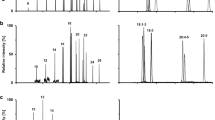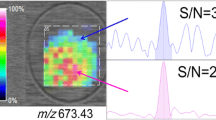Abstract
Serum vitamin D metabolite levels are of interest as biomarkers for vitamin D status, which has influence on numerous body functions and pathologies. The determination of vitamin D metabolite levels by liquid chromatography/mass spectrometry (LC/MS) is challenging due to their low concentrations and relatively low ionization efficiencies. Three ionization sources, dielectric barrier discharge ionization (DBDI), atmospheric pressure chemical ionization (APCI), and electrospray ionization (ESI), were compared regarding achievable limits of detection and occurring matrix effects. The latter were mainly caused by phospholipids. Therefore, in addition to a conventional solid phase extraction (SPE) stationary phase, a material for selective removal of phospholipids was examined. The selective removal of phospholipids significantly reduced observed matrix effects, especially when ESI was applied. Achievable limits of detection and observed matrix effects were lowest for APCI and with some limitations, also for DBDI.

Graphical abstract






Similar content being viewed by others
References
Prentice A, Goldberg GR, Schoenmakers I. Vitamin D across the lifecycle: physiology and biomarkers. Am J Clin Nutr. 2008;88:500S–6S.
Holick MF. Vitamin D deficiency. N Engl J Med. 2007;357:266–81.
Donkena KV, Young CY. Vitamin d, sunlight and prostate cancer risk. Adv Prev Med. 2011;2011:281863.
Gueli N, Verrusio W, Linguanti A, Di Maio F, Martinez A, Marigliano B, et al. Vitamin D: drug of the future. A new therapeutic approach. Arch Gerontol Geriatr. 2012;54:222–7.
Shipowick CD, Moore CB, Corbett C, Bindler R. Vitamin D and depressive symptoms in women during the winter: a pilot study. Appl Nurs Res. 2009;22:221–5.
Norman AW. From vitamin D to hormone D: fundamentals of the vitamin D endocrine system essential for good health. Am J Clin Nutr. 2008;88:491S–9S.
Crawford BA, Labio ED, Strasser SI, McCaughan GW. Vitamin D replacement for cirrhosis-related bone disease. Nat Clin Pract Gastroenterol Hepatol. 2006;3:689–99.
Singh RJ, Taylor RL, Reddy GS, Grebe SKG. C-3 epimers can account for a significant proportion of total circulating 25-hydroxyvitamin D in infants, complicating accurate measurement and interpretation of vitamin D status. J Clin Endocrinol Metab. 2006;91:3055–61.
Carter GD. Accuracy of 25-hydroxyvitamin D assays: confronting the issues. Curr Drug Targets. 2011;12:19–28.
El-Khoury JM, Reineks EZ, Wang S. Progress of liquid chromatography-mass spectrometry in measurement of vitamin D metabolites and analogues. Clin Biochem. 2011;44:66–76.
Volmer DA, Mendes LRBC, Stokes CS. Analysis of vitamin D metabolic markers by mass spectrometry: current techniques, limitations of the “gold standard” method, and anticipated future directions. Mass Spectrom Rev. 2015;34:2–23.
Na N, Zhang C, Zhao M, Zhang S, Yang C, Fang X, et al. Direct detection of explosives on solid surfaces by mass spectrometry with an ambient ion source based on dielectric barrier discharge. J Mass Spectrom. 2007;42:1079–85.
Zhang Y, Ma X, Zhang S, Yang C, Ouyang Z, Zhang X. Direct detection of explosives on solid surfaces by low temperature plasma desorption mass spectrometry. Analyst. 2009;134:176–81.
Ma X, Zhang S, Lin Z, Liu Y, Xing Z, Yang C, et al. Real-time monitoring of chemical reactions by mass spectrometry utilizing a low-temperature plasma probe. Analyst. 2009;134:1863–7.
Michels A, Tombrink S, Vautz W, Miclea M, Franzke J. Spectroscopic characterization of a microplasma used as ionization source for ion mobility spectrometry. Spectrochim Acta, Part B. 2007;62:1208–15.
Hayen H, Michels A, Franzke J. Dielectric barrier discharge ionization for liquid chromatography/mass spectrometry. Anal Chem. 2009;81:10239–45.
Gilbert-López B, García-Reyes JF, Meyer C, Michels A, Franzke J, Molina-Díaz A, et al. Simultaneous testing of multiclass organic contaminants in food and environment by liquid chromatography/dielectric barrier discharge ionization-mass spectrometry. Analyst. 2012;137:5403–10.
Mirabelli MF, Wolf JC, Zenobi R. Pesticide analysis at ppt concentration levels: coupling nano-liquid chromatography with dielectric barrier discharge ionization-mass spectrometry. Anal Bioanal Chem. 2016;408:3425–34.
Ding S, Schoenmakers I, Jones K, Koulman A, Prentice A, Volmer DA. Quantitative determination of vitamin D metabolites in plasma using UHPLC-MS/MS. Anal Bioanal Chem. 2010;398:779–89.
Author information
Authors and Affiliations
Corresponding author
Ethics declarations
Conflict of interest
The authors declare that they have no conflicts of interest.
Electronic supplementary material
ESM 1
(PDF 596 kb)
Rights and permissions
About this article
Cite this article
Hagenhoff, S., Hayen, H. LC/MS analysis of vitamin D metabolites by dielectric barrier discharge ionization and a comparison with electrospray ionization and atmospheric pressure chemical ionization. Anal Bioanal Chem 410, 4905–4911 (2018). https://doi.org/10.1007/s00216-018-1137-0
Received:
Revised:
Accepted:
Published:
Issue Date:
DOI: https://doi.org/10.1007/s00216-018-1137-0




